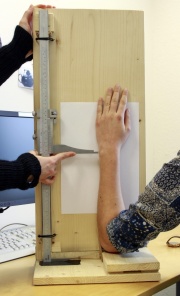Discovery of a potential new indicator of pubertal hormone levels linked to human power motivation
|
A recent study by the HuMAN Lab, published in the journal Adaptive Human Behavior and Physiology may have discovered a previously hidden indicator of the hormone levels people are exposed to during puberty: The ulna-to-fibula ratio (UFR). In a study with 73 female and 53 male participants, Köllner and Bleck measured the length of long bones in arm and leg with calipers and a newly derived Arm-Length Measuring Apparatus (ALMA, see top figure). They found that the ratio of two long bones, the ulna (one of two bones of our forearm) and the fibula (one of the two bones of the shank) was higher in men compared two women. „We assume that this sex difference forms at the time of puberty, because puberty is a time of a massive sex-hormone-driven bone growth spurt. Levels of estradiol and testosterone rise markedly during this developmental window and sex differences in these hormones may be responsible for the longer forearms in relation to the shank in men compared to women,“ Bleck states. Another reason why the authors believe UFR provides information about pubertal hormones is the fact that long bone growth is finished after puberty and sex hormones are not able to further modify long bone length in adulthood.
In addition, the hormones that we were exposed to during puberty – as indexed by UFR - seem to contribute to our adult motivational need for power. Köllner and Bleck also assessed power motivation with a picture-story task in the same participants. They found that men with a low UFR were higher in the need for power than other men. Conversely, women with a high UFR were higher in the need for power than other women (see bottom figure). Comments Köllner: „It is no surprise that the findings differ between women and men, because the two sexes are exposed to very different levels of sex hormones during puberty, with estradiol being higher in women and testosterone being higher in men.“ These results bear a striking resemblance to earlier results that documented relationships between indicators of prenatal (2D:4D digit ratio) and pubertal (facial width-to-height ratio) hormones and the need for power. These results also showed different patterns for men and women. As a next step, Köllner and Bleck are planning to confirm their findings in larger samples. Later, they want to determine when the sex difference in UFR arises by testing children and adolescents of varying ages
|

.jpg)
This figure shows the main findings for the Ulna-to-Fibula Ratio (UFR) and the need for power. Women with a higher UFR were higher in the need for power, while the reverse tended to be true for men. Figures available at https://osf.io/afmrg |
What motivates you as an adult may depend on the hormones you were exposed to as a fetus
David Winter presents talk on the roots of war
Competition, aggression, and hormones
Women are more affiliation-motivated than men
Why the power-motivated are better at parking their cars
New meta-analysis: Low to no correlation between implicit and explicit motive measures
Content-coding motive measures can be approcimated with automated word counts
Exploiting the full potential of thematic apperception through profile analysis
High progesterone is associated with less coherent brains (August 2012)
What color naming speed reveals about the wisdom of
one's goal choices (December 2010)
Are you high on testosterone and is that a good thing? Listen to Podcast of interview with Dr. Oliver Schultheiss on UM NewsService
New edited book on implicit motives available (October 2009)
What the word "not" may reveal about your ability to handle stress (October 2008)
Estrogen fuels female power (February 2008)
High-testosterone people reinforced by others’ anger, new study finds (February 2007)
Study finds US students more motivated to achieve, less power-hungry than German students (August 2006)
Are all people stressed out by a defeat or does it hurt some more than others? (April 2006)
|

